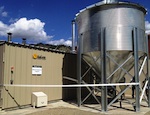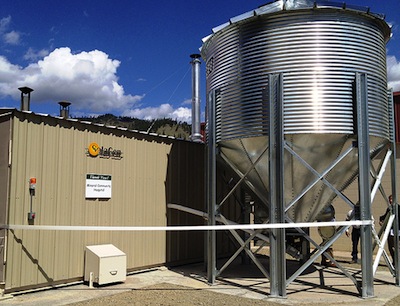
Hospital uses beetle-kill sourced wood pellets
October 5, 2012
By USDA Forest Service
 October 5, 2012, Superior, MT – The new Mineral Hospital Biomass Generator will use woody material such as beetle-killed trees removed from forests to help prevent wildfires.
October 5, 2012, Superior, MT – The new Mineral Hospital Biomass Generator will use woody material such as beetle-killed trees removed from forests to help prevent wildfires.
The material will then be processed in bioenergy facilities to produce green energy for heating and electricity.
Mineral Community Hospital received an $190,000 Woody Biomass Utilization Grant from the U.S. Forest Service.
The new biomass system uses a combustion boiler that burns 180 tons of pellets annually. The new system replaces a 1975 fuel-oil burning system. The renewable wood energy project will create fewer emissions and lower heating and cooling cost by nearly $50,000 a year. Mineral Community Hospital, along with Clark Valley Hospital in Plains, are the first two hospitals in Montana to implement the use of a woody biomass heating system. It’s hoped they will serve as a model for other private and public institutions throughout the Montana region considering the woody biomass fuel source.
A feasibility study reveals that a woody biomass energy system would be cost-effective. The wood pellets for the system are produced at the Eureka Pellet Mill in Superior. It’s been concluded that these efforts will create needed jobs and retention in the timber industry in Mineral County.

|
|
| The new biomass system at Mineral Community Hospital burns 180 tons of pellets annually. (Photo: Mineral Community Hospital)
|
“The new biomass system allows us to get our fuel locally, helping to stimulate the economy, saves us money, and will be more efficient than other heating alternatives,” said Steve Carty, CEO of Mineral Community Hospital.
Montana Lieutenant Governor John Bohlinger said, “The Mineral Community Hospital biomass energy system is an important step in diversifying the energy we consume. Using biomass, a readily available local source of fuel, is cost-effective and keeps money in the local economy.”
The annual cost savings will be used to improve patient care at the hospital and clinic. The $450,000 project is funded in part from a grant from the Montana Department of Natural Resources and Conservation and the Montana Department of Environmental Quality.
Print this page